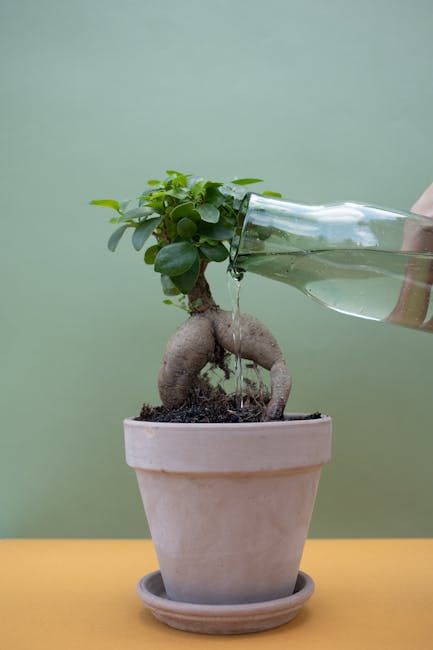Indoor bonsai trees hold a special place for enthusiasts, offering a little slice of nature indoors. When it comes to bonsai, watering is perhaps the most crucial part of its care regimen. The key to a healthy bonsai lies in understanding its watering needs, which help maintain its health and extend its lifespan.
Each bonsai tree type has its quirks, and that includes how much water it needs. We’re talking about different species having different thirst levels. Aficionados know that digging into the specific needs of your bonsai species can save your plant from drama down the line. Whether it’s a tropical or a temperate variety, every bonsai has its water requirements.
There’s a lot of talk about overwatering and underwatering, so let’s clear things up. Overwatering can suffocate the roots, while too little water can lead to wilt and despair. Spotting these issues early can prevent long-term damage, so knowing the signs is vital. Think yellowing leaves for too much water and dry, crispy foliage for too little.
Taking a moment to inspect your plant can tell you everything you need to know about its water situation. Leaves tell stories—crispy edges, wilting, or yellowing mean it’s time to re-evaluate your watering game. A daily check is a good habit that can make a big difference in your bonsai journey.
Factors Affecting Watering Needs: The Role of Environment
Watering your indoor bonsai isn’t just about pouring the right amount of H2O; it’s about tuning into its environment. Indoor conditions can sway how often and how much you should water. You might not realize it, but things like humidity and temperature do a number on your bonsai’s thirst levels.
Humidity isn’t just a weather stat—it’s a game changer for watering routines. Low humidity indoors, especially in winter with the heating on, can make your bonsai drink up more often than it would in a humid environment. Keeping an eye on these levels becomes key to adjusting your schedule. Humidifiers can help maintain a balanced environment.
Temperature also stirs the pot when it comes to watering needs. Warmer temperatures tend to evaporate moisture faster, leaving your bonsai parched more quickly. Conversely, during colder months, the reduced evaporation rate might mean cutting back on how often you water. Consider moving your bonsai to a spot that’s not subject to drastic temperature changes.
The potting mix plays a starring role too—some mixes dry out quickly, while others hold onto moisture like their life depends on it. Understanding your mix aids in watering correctly. If you’ve got a fast-drying mix, you’ll need to water more frequently, and vice versa. A well-draining mix helps keep overwatering at bay, providing just the right hold on water.
Seasonal changes? They’re not just for fashion. These shifts can radically alter your bonsai’s hydration needs. Spring may bring more watering due to increased growth, while less water is often wanted during its dormancy in winter. Being adaptable with your watering routine during different times of the year is part of mastering indoor bonsai care.
Step-by-Step Guide to Watering Your Indoor Bonsai
Watering your indoor bonsai isn’t just an art; it’s a practiced routine. Figuring out when your bonsai’s thirsty might seem tricky, but there are some foolproof ways to tell. Stick a finger an inch into the soil—if it’s dry, it’s showtime. Moist might mean a short delay for your watering can.
Pouring water until it drains out of the pot shows you’re getting it right—a deep soak ensures water reaches the roots. Be patient, giving time for absorption. And don’t flood the leaves; aim straight for the soil.
There are a handful of watering tricks out there. A good soak is classic, making sure water hits all those parched roots. For finer droplets, try misting, which some bonsais really dig. Just skip the regular spray bottle for a spout that flows smoothly.
Sometimes gadgets can lend a hand. Moisture meters are handy sidekicks in the watering game, useful for ensuring that extra precision. So as much as you might want to throw caution to the wind, staying on top of your schedule with the help of a little tech never hurts.
Troubleshooting Common Watering Issues
When watering doesn’t go as planned, don’t hit panic mode. One common hiccup is overwatering, which mostly manifests as yellow leaves and a sad-looking plant. Fixing this involves dialing back on the watering and maybe reconsidering that drainage setup. Removing excess water quickly can sometimes save the day.
On the flip side, missing your bonsai’s dry signs could lead to underwatering. Brown, crispy leaves scream for moisture. Reviving an underwatered bonsai means a deep soak to rehydrate those roots—make peace with water’s healing properties, allowing your plant to bounce back.
Being proactive means fewer surprises. Think about setting up a watering schedule tuned to your bonsai’s species and your home climate. Strategically checking the soil’s dampness can catch problems before they take hold.
Getting consistent with watering routines makes life a lot easier for both you and your bonsai. With each round of watering, you’re mastering your plant’s needs and creating an environment that supports growth and vitality.
